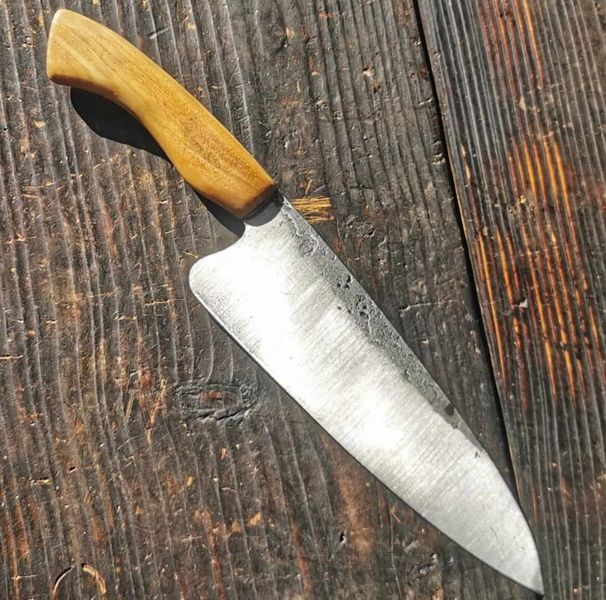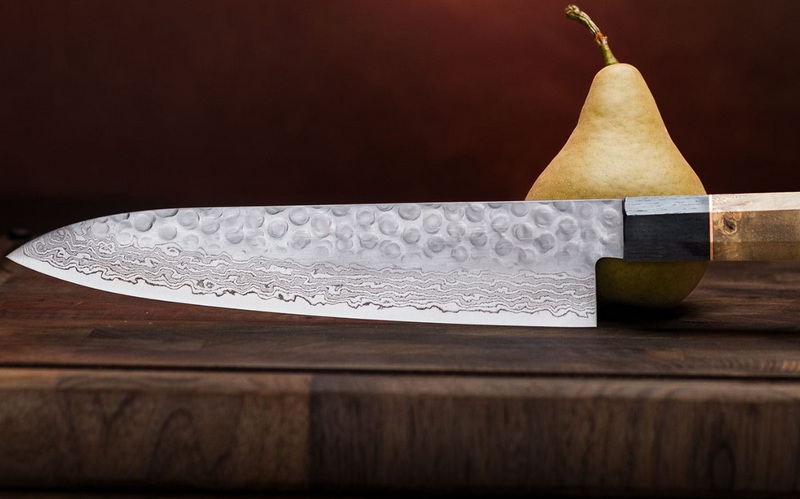- All
- Product Name
- Product Keyword
- Product Model
- Product Summary
- Product Description
- Multi Field Search
Views: 222 Author: Ann Publish Time: 2025-10-16 Origin: Site











Content Menu
● Introduction to Damascus Knives
● Step 1: Selecting the Steel Layers
● Step 4: Drawing Out and Shaping the Billet
● Step 5: Annealing and Normalizing
● Step 6: Hardening and Tempering
● Step 7: Grinding and Profiling
● Step 9: Final Polishing and Handle Assembly
● Step 10: Quality Inspection and Packaging
● Additional Considerations in Damascus Knife Production
>> Blade Thickness and Edge Angles
>> Handle Ergonomics and Safety
>> Maintenance and Care Instructions
>> 1. What makes Damascus Knives different from regular knives?
>> 2. How many layers does a typical Damascus blade have?
>> 3. Why is acid etching used on Damascus blades?
>> 4. Can Damascus Knives be sharpened like other knives?
>> 5. Are Damascus Knives suitable for professional kitchens?
The Damascus Knife is celebrated worldwide for its exceptional craftsmanship, striking aesthetics, and remarkable performance. As a Chinese kitchen knife factory providing OEM services for international brands, we take immense pride in our mastery of the Damascus blade-making process. This article explores the intricate steps involved in creating a Damascus knife, from forging the layered steel to the final finishing touches.

The Damascus Knife is distinguished by its characteristic wavy or watery patterns on the blade surface. These patterns are not just for beauty; they represent the sophisticated layering and forging of multiple steels, combining hardness with flexibility — crucial qualities for a professional kitchen knife.
The origin of Damascus knives traces back centuries to the Middle East, but modern Damascus steel knives are typically created using advanced forging methods that blend ancient techniques with contemporary metallurgy, ensuring top-tier quality and sharpness tailored for sophisticated culinary needs.
Crafting a Damascus Knife begins with selecting high-quality steels. Typically, two or more types of steel with distinct carbon content are chosen. This contrast ensures the blade achieves both sharpness and durability.
The most common steels used include 1095 high carbon steel for hardness and 15N20 nickel steel for flexibility and corrosion resistance. The balance of these steels forms the backbone of a superior Damascus blade.
The steels are cut into the desired sizes and stacked in alternating layers to form a billet. This stack is carefully aligned to ensure consistent layering throughout the blade.
The precision of stacking affects the final pattern and blade integrity, so expert smiths meticulously arrange the layers with exact parallel alignment.
The stacked billet is heated in a forge to a red-hot temperature and then hammered or pressed to fuse the layers together. This forge welding process is repeated several times, sometimes hundreds, producing thousands of layers in the blade.
Once welded, the billet is elongated and shaped roughly into a knife blank. This step refines the layers and aligns the grain of the steel for optimal strength.
Different shaping tools, including belt grinders and hand files, are used to sculpt the blank closer to the desired knife profile like chef's knife, cleaver, or utility blade.
The knife blank undergoes heat treatments like annealing and normalizing to relieve internal stresses and prepare for hardening. These steps ensure the blade can withstand future thermal processes without warping.
Annealing softens the steel, allowing for detailed grinding and shaping without cracking. Normalizing refines the grain structure, enhancing toughness.

The blank is heated to a critical temperature and then quenched rapidly to harden the steel. Tempering follows to reduce brittleness and improve toughness. This combination is crucial for kitchen knives to retain sharp edges without breaking.
A key consideration is the choice of quenching medium, such as oil or water, which affects the blade's microstructure and hardness.
The hardened blade is ground to its final shape and edge profile. This process involves carefully removing material to create the intended blade geometry and bevel, preparing for polishing.
Different grits of abrasive belts and stones are used progressively until a smooth, sharp edge is achieved. Ergonomics are also considered to ensure balanced and comfortable handling.
To reveal the unique Damascus pattern, the blade is immersed in an acid solution which etches the different steels at varying rates. This highlights the layers and creates the mesmerizing patterns.
Popular etching agents include ferric chloride or hydrochloric acid diluted safely. Timing and concentration are crucial for a vibrant and well-defined pattern.
Skilled artisans polish the blade to a smooth finish, enhancing both appearance and feel. The handle, crafted from premium materials such as stabilized wood, micarta, or exotic hardwoods, is then fitted securely to the blade tang, completing the Damascus Knife.
Handle design aims to blend beauty, grip comfort, and durability, often customized per OEM client specifications.
Each Damascus Knife undergoes rigorous quality checks for balance, sharpness, and aesthetic perfection before being carefully packaged.
Packaging is often tailored for premium presentation, including printed boxes, protective sheaths, and custom branding elements for export markets.
The blade thickness must be optimized to balance strength and sharpness. Typically, kitchen Damascus knives are ground between 2.5 to 4 mm thick near the spine, tapering delicately towards the cutting edge.
Edge angle selection depends on intended use: professional chef knives usually have a 15° angle per side, while heavier-duty cleavers may have 20° angles for durability.
Well-designed handles reduce hand fatigue during prolonged kitchen work. Features often include contoured grips, finger guards, and non-slip textures. Integrated rivets or full tang construction ensures stability.
Damascus knives require special care to maintain their beauty and performance. Cleaning with mild dish soap, drying immediately, and occasional oiling prevents rust. Sharpening should follow OEM recommended methods.
The artistry behind a Damascus Knife blends tradition, technology, and meticulous craftsmanship. From selecting steels and forging layers to the final polish and precise handle assembly, every step is key to producing blades admired worldwide for their performance and beauty. Our factory's OEM services ensure that brands receive top-quality Damascus Knives, combining this rich heritage with modern manufacturing standards to meet diverse market demands.

Damascus Knives feature multiple layers of steel forged together, creating distinctive patterns and combining strength with flexibility.
The number varies but commonly ranges from 100 to over 500 layers, achieved through repeated forging.
Acid etching exposes the layered steel pattern by corroding different steels at different rates.
Yes, they can be sharpened with standard knife sharpening techniques while retaining their core strength.
Absolutely, they are prized by chefs for their sharpness, durability, and aesthetic appeal.
The Ultimate Professional Knives for Halal Butchery in Middle Eastern Kitchens
Chef Knife Size Guide: Choosing Between 6″, 8″, 10″, And 12″
Custom Knife Handles: How To Design A Chef Knife That Fits Your Hand Perfectly
Chef Knife Surface Treatments Guide: From Polished Migaki To Damascus Patterns
Inside Our Professional Knife Sample Room: Quality You Can See
Universal Knife Block Buying Guide: Modern Acrylic & ABS Knife Holders for Professional Kitchens
Universal Knife Block: The Complete Guide To Modern, Hygienic Knife Storage
The Complete Guide To Red Handle Knife Sets: Style Meets Functionality in The Kitchen
Professional Knives for Halal Butchery And Middle Eastern Cuisine